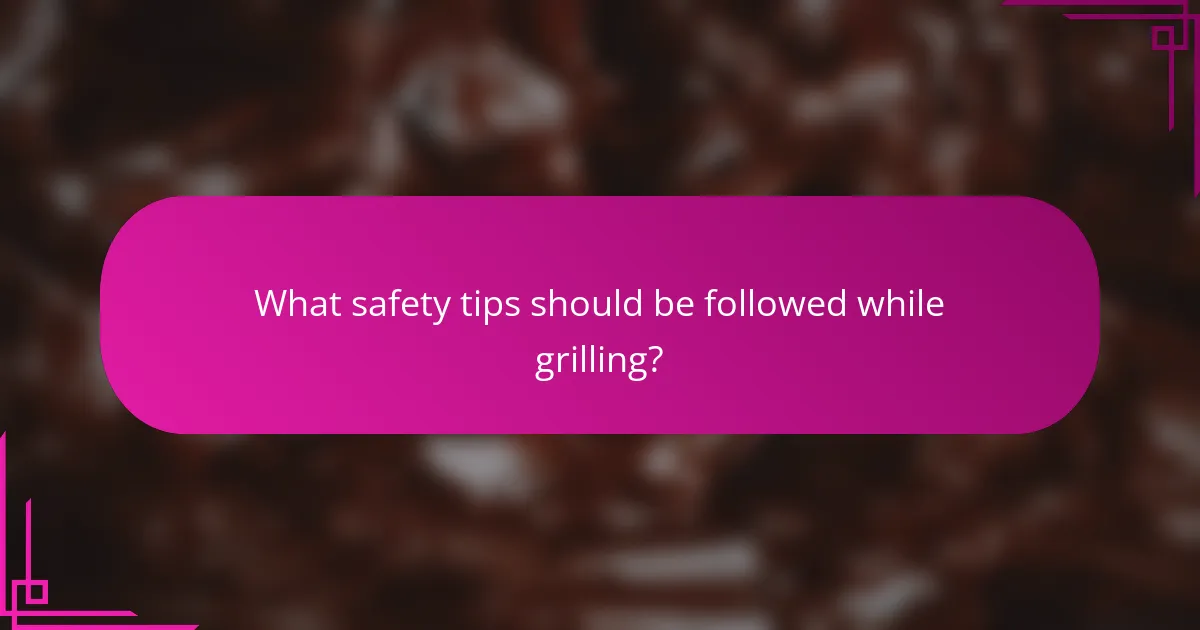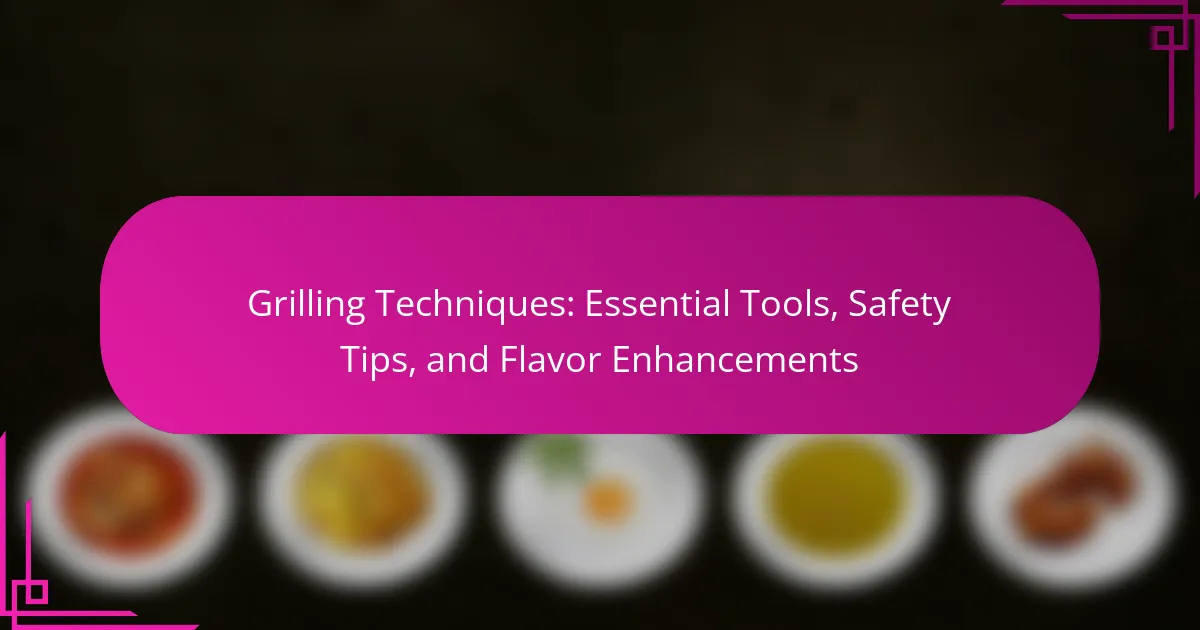Grilling techniques encompass direct grilling, indirect grilling, and smoking, each offering unique cooking methods that influence food texture and flavor. Direct grilling cooks food over a heat source, ideal for quick items like burgers, while indirect grilling surrounds larger cuts with heat for thorough cooking. Smoking infuses food with flavor at lower temperatures using wood smoke. Essential safety tips include keeping a fire extinguisher nearby, using long-handled tools, and maintaining a clean grill. Flavor enhancements, such as marinating and seasoning with herbs, spices, and smoking wood chips, further elevate the grilling experience. Understanding these techniques and safety measures can significantly improve grilling skills and meal quality.

What are the essential grilling techniques?
The essential grilling techniques include direct grilling, indirect grilling, and smoking. Direct grilling involves cooking food directly over the heat source. This method is ideal for quick-cooking items like burgers and vegetables. Indirect grilling uses heat surrounding the food, suitable for larger cuts like whole chickens or roasts. Smoking involves cooking food at lower temperatures with wood smoke for flavor. Each technique affects the texture and taste of the food. Mastering these methods enhances grilling skills and improves meal quality.
How do different grilling methods impact flavor?
Different grilling methods significantly impact flavor through variations in heat intensity and cooking techniques. Direct grilling imparts a smoky char and caramelization from high heat. This method enhances the Maillard reaction, creating complex flavors. Indirect grilling produces a gentler heat, allowing for even cooking and moisture retention. This method often results in more tender meats with a subtle flavor profile. Smoking adds unique flavors from wood chips, infusing the food with aromatic compounds. Each method contributes distinct taste characteristics, influencing the overall culinary experience.
What are the differences between direct and indirect grilling?
Direct grilling involves cooking food directly over the heat source. This method is ideal for smaller, tender cuts of meat. It typically results in a quicker cooking time and creates a charred exterior. Indirect grilling, on the other hand, cooks food beside the heat source rather than directly over it. This method is suitable for larger cuts of meat that require longer cooking times. Indirect grilling allows for even cooking and reduces the risk of burning. The two methods differ mainly in heat application and cooking technique. Direct grilling is faster, while indirect grilling is more suitable for slow cooking.
How can grilling techniques enhance the texture of food?
Grilling techniques can enhance the texture of food by creating a desirable char and crispness. The high heat of grilling promotes the Maillard reaction, which browns the surface of the food. This reaction adds complexity to the flavor and creates a crunchy exterior. Additionally, grilling allows excess moisture to escape, resulting in a firmer texture. The direct exposure to flames can also cause caramelization of natural sugars in the food, enhancing both texture and taste. Various techniques, such as direct and indirect grilling, can further influence how the texture develops. For instance, indirect grilling can tenderize meats while still providing a crispy outer layer. These methods are widely recognized in culinary practices for their effectiveness in improving food texture.
What tools are essential for effective grilling?
Essential tools for effective grilling include a grill, tongs, a spatula, and a meat thermometer. A grill is the primary cooking equipment for grilling various foods. Tongs are crucial for flipping and handling food safely. A spatula aids in lifting and serving grilled items. A meat thermometer ensures proper cooking temperatures for meats, which is vital for food safety. Additionally, a grill brush is important for maintaining cleanliness and hygiene. These tools collectively enhance the grilling experience and improve food quality.
Which grilling tools are must-haves for beginners?
A beginner’s must-have grilling toolset includes a grill, tongs, a spatula, and a grill brush. The grill serves as the primary cooking appliance for grilling. Tongs are essential for flipping and moving food safely. A spatula allows for easy handling of burgers and delicate items. A grill brush is crucial for maintaining a clean cooking surface. These tools enhance the grilling experience and improve safety and efficiency. Having these basic tools ensures beginners can grill effectively and enjoyably.
How do advanced tools improve grilling results?
Advanced tools enhance grilling results by providing precision and control. Digital thermometers ensure accurate temperature readings, preventing overcooking. Smart grills offer consistent heat distribution, resulting in even cooking. Grill mats prevent flare-ups and retain moisture, improving flavor. Advanced fuel systems allow for adjustable heat levels, optimizing cooking times. Research shows that using these tools can increase satisfaction in grilling outcomes. A study from the Journal of Culinary Science found that precision tools improved meat tenderness by 15%.

What safety tips should be followed while grilling?
Always keep a fire extinguisher nearby when grilling. This ensures quick response to any flare-ups. Use grilling tools with long handles to avoid burns. Wear heat-resistant gloves for added protection. Keep the grill clean to prevent grease fires. Ensure the grill is on a stable surface to avoid tipping. Never leave the grill unattended while in use. Use a meat thermometer to ensure food is cooked to safe temperatures. Following these tips can significantly reduce the risk of accidents while grilling.
How can one prevent accidents during grilling?
To prevent accidents during grilling, ensure proper safety measures are in place. Always keep a fire extinguisher nearby. Use long-handled tools to avoid burns. Never leave the grill unattended while in use. Maintain a safe distance from flammable materials. Ensure the grill is on a stable surface to prevent tipping. Clean the grill regularly to avoid flare-ups from grease buildup. Use appropriate protective gear, such as heat-resistant gloves. Following these guidelines significantly reduces the risk of accidents.
What precautions should be taken with propane grills?
Always ensure proper ventilation when using propane grills. This prevents gas buildup and reduces the risk of explosion. Regularly check for gas leaks by applying soapy water to connections. Bubbles indicate a leak that needs immediate attention. Keep the grill away from flammable materials, such as wood or paper. This minimizes fire hazards. Store propane tanks upright in a cool, well-ventilated area. This prevents pressure buildup and potential leaks. Always turn off the gas supply when the grill is not in use. This ensures safety and prevents accidental ignition. Follow manufacturer instructions for safe operation and maintenance. Proper adherence to these precautions significantly reduces the risk of accidents.
How to handle hot surfaces and prevent burns?
To handle hot surfaces and prevent burns, always use heat-resistant gloves or mitts. These protective items can withstand high temperatures and provide a barrier between skin and hot surfaces. Ensure that tools like tongs or spatulas are used to move food away from direct heat. This reduces the risk of accidental contact with hot surfaces.
Keep a safe distance from the grill or hot cooking area. Standing too close increases the chance of burns. Always check the temperature of surfaces before touching them. Use an infrared thermometer to measure surface heat accurately.
Educate others around you about the dangers of hot surfaces. Awareness can prevent accidental burns. Lastly, never leave hot surfaces unattended. This can lead to accidents, especially in crowded areas.
What are the best practices for food safety while grilling?
The best practices for food safety while grilling include keeping raw and cooked foods separate. This prevents cross-contamination. Use separate utensils and plates for raw meat and cooked items. Always wash hands before handling food and after touching raw meat. Marinate food in the refrigerator, not on the counter. Cook food to the recommended internal temperatures; for poultry, it should reach 165°F, while ground meats should hit 160°F. Use a food thermometer to ensure accuracy. Finally, keep grilled food hot until serving, ideally above 140°F. Following these practices reduces the risk of foodborne illnesses.
How can cross-contamination be avoided?
To avoid cross-contamination, separate raw and cooked foods. Use different cutting boards for meats and vegetables. Clean utensils and surfaces thoroughly between uses. Store raw meats on the bottom shelf of the refrigerator. Always wash hands after handling raw foods. The CDC states that proper food handling reduces the risk of foodborne illness.
What are the recommended internal temperatures for grilled meats?
The recommended internal temperatures for grilled meats vary by type. For poultry, the safe internal temperature is 165°F (74°C). Ground meats, like beef and pork, should reach 160°F (71°C). Whole cuts of beef, lamb, and pork are safe at 145°F (63°C) and should rest for at least three minutes. Fish should be cooked to an internal temperature of 145°F (63°C). These temperatures ensure that harmful bacteria are killed, making the meat safe to consume. The USDA provides these guidelines to help prevent foodborne illnesses.

How can flavors be enhanced while grilling?
Marinating meats and vegetables enhances flavors while grilling. Marinades infuse ingredients with spices, acids, and oils. Acidic components like vinegar or citrus tenderize proteins, enhancing texture. Using herbs and spices adds depth to the taste profile. Additionally, seasoning with salt before grilling can intensify natural flavors. Smoking wood chips can introduce unique flavors during the grilling process. Experimenting with different wood types, like hickory or mesquite, can yield varied taste experiences. Grilling at the right temperature also helps in caramelizing sugars, adding complexity to flavors.
What marinades and rubs work best for grilling?
Acidic marinades and dry rubs work best for grilling. Acidic marinades typically include ingredients like vinegar, citrus juice, or yogurt. These components tenderize meat and enhance flavor. Dry rubs consist of a blend of spices and herbs. Popular ingredients in dry rubs include paprika, garlic powder, and brown sugar. These enhance the crust and provide a flavorful exterior. Research shows that marinating for at least 30 minutes improves flavor absorption. Additionally, using rubs before grilling can create a caramelized crust due to the Maillard reaction.
How do different ingredients affect the flavor profile?
Different ingredients significantly influence the flavor profile of grilled foods. For instance, herbs and spices add depth and complexity. Ingredients like garlic and onion impart strong, aromatic qualities. Sweet elements, such as honey or brown sugar, enhance caramelization and provide balance. Acidic components, such as citrus juice or vinegar, brighten flavors and tenderize proteins. Fatty ingredients, like oils or butter, contribute richness and moisture. Each ingredient interacts uniquely with heat, altering taste perception. Studies show that flavor compounds in ingredients can change when exposed to high temperatures, affecting overall taste.
What are some unique flavor combinations to try?
Mango and chili is a unique flavor combination to try. The sweetness of mango pairs well with the heat of chili. This contrast enhances the overall taste experience. Another combination is rosemary and lemon. Rosemary adds a savory note, while lemon provides brightness. This pairing works well with grilled meats and vegetables. Additionally, try bacon and maple syrup. The saltiness of bacon complements the sweetness of maple syrup. This combination is popular in breakfast dishes and desserts. Lastly, consider chocolate and chili. The richness of chocolate combined with chili’s heat creates a complex flavor profile. These combinations offer diverse taste experiences that can elevate grilled dishes.
How can smoking techniques improve grilled flavors?
Smoking techniques enhance grilled flavors by infusing food with rich, complex aromas. The process involves using wood chips or chunks that burn slowly to create smoke. This smoke interacts with the meat, vegetables, or fish, adding depth to the flavor profile. Different types of wood, such as hickory or mesquite, impart unique tastes. For example, hickory provides a strong, hearty flavor, while applewood offers a milder, sweeter note. Additionally, smoking can tenderize proteins through low and slow cooking, breaking down tough fibers. Studies have shown that smoked foods often have higher perceived flavor intensity. This technique is widely utilized in barbecue traditions worldwide, demonstrating its effectiveness in flavor enhancement.
What types of wood chips are best for smoking?
Hickory, mesquite, apple, and cherry wood chips are best for smoking. Hickory provides a strong, hearty flavor, ideal for meats like pork and ribs. Mesquite offers an intense, earthy taste, commonly used for beef. Apple wood chips impart a mild, sweet flavor, perfect for poultry and fish. Cherry wood chips add a subtle sweetness and a rich color to smoked foods. Each type enhances the flavor profile of the food being smoked, making them popular choices among grillers.
How does smoking time impact flavor intensity?
Smoking time directly affects flavor intensity. Longer smoking times generally result in a more pronounced flavor. This is due to the gradual absorption of smoke compounds by the food. The Maillard reaction also intensifies flavors over extended cooking periods. Different types of wood produce varying flavor profiles, which are enhanced with time. For instance, hickory offers a strong flavor, while fruit woods provide a milder taste. Studies indicate that optimal smoking times can vary by meat type and thickness. For example, brisket may require several hours of smoking to achieve desired flavor depth.
What are some common troubleshooting tips for grilling?
Ensure the grill is clean to prevent flare-ups. Check the fuel supply if the grill isn’t lighting. Verify that the burners are functioning properly. Adjust the heat settings for even cooking. Use a meat thermometer to ensure proper doneness. Allow the grill to preheat for optimal results. Keep a spray bottle of water handy for flare control. Check for gas leaks by applying soapy water to connections.
How can uneven cooking be addressed?
Uneven cooking can be addressed by ensuring consistent heat distribution during grilling. Use a two-zone fire setup to create areas of direct and indirect heat. This allows for searing food over high heat while cooking it through in a cooler zone. Regularly rotate food on the grill to promote even cooking. Additionally, preheating the grill and using a thermometer can help achieve the desired internal temperature. Research shows that using these techniques can lead to more uniformly cooked meals.
What should be done if food sticks to the grill?
To prevent food from sticking to the grill, preheat the grill properly before cooking. A hot grill surface helps create a natural non-stick effect. Additionally, oil the grill grates before placing food on them. Use a paper towel soaked in oil and tongs to apply it evenly.
If food does stick, avoid forcefully scraping it off. Instead, let it cook a bit longer; food often releases naturally when it’s ready to flip. If necessary, use a spatula to gently lift the edges.
Proper grill maintenance also plays a crucial role. Regularly clean the grill grates after each use to remove residue. This practice reduces sticking in future grilling sessions.
The main entity of this article is grilling techniques, which encompass essential methods, tools, safety tips, and flavor enhancements. Key techniques include direct grilling, indirect grilling, and smoking, each impacting the texture and flavor of food differently. The article outlines essential tools for successful grilling, best practices for food safety, and methods to enhance flavors through marinades and smoking. Additionally, it provides troubleshooting tips for common grilling issues, ensuring a comprehensive understanding of effective grilling practices.
